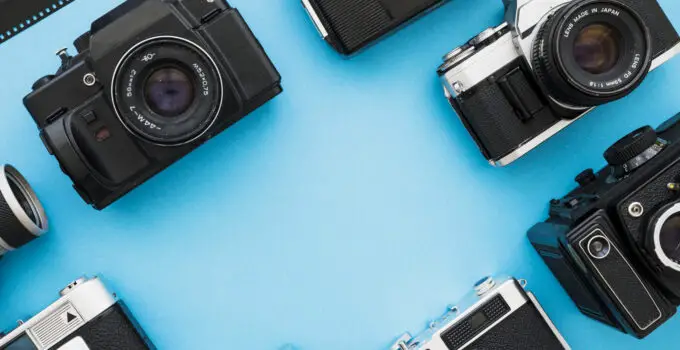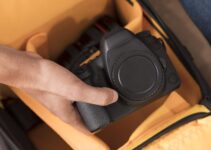Table of Contents
ToggleHow do you ensure your dome camera captures clear footage? Keeping the camera cover clean is essential.
Dust, fingerprints, and dirt can obscure the lens, affecting image quality and performance. Regular cleaning not only maintains visibility but also extends the lifespan of your surveillance equipment.
By following a few simple steps, you can effectively clean the dome camera cover and ensure uninterrupted surveillance.
Let’s explore the best methods to keep your dome camera in optimal condition.”
Here, who makes the best camera bag?
When to clean a dome camera cover?
Cleaning a dome camera cover is crucial for maintaining clear surveillance footage. The frequency of cleaning depends on environmental factors such as dust, pollen, and weather conditions.
Generally, it’s recommended to clean the dome cover at least once a month to prevent build-up that can obscure the camera’s view.
If the camera is installed in a particularly dusty or dirty environment, more frequent cleaning may be necessary.
To clean the dome cover, first, power off the camera to avoid electrical hazards.
Use a soft, lint-free cloth with a mild cleaning solution or a lens cleaner specifically designed for camera lenses. Gently wipe the dome cover in a circular motion to remove dust and smudges.
Avoid abrasive materials or strong chemicals that could scratch or damage the dome cover.
Inspect the camera regularly for any signs of dirt or obstruction and clean as needed to ensure optimal performance and clear footage capture.
Is it worth to clean a dome camera cover?
Yes, it is worth cleaning a dome camera cover regularly to maintain effective surveillance.
A clean dome cover ensures that the camera can capture clear and unobstructed footage, which is crucial for security and monitoring purposes.

Dirt, dust, and smudges on the dome cover can significantly degrade the camera’s performance by reducing image clarity and possibly obstructing the view entirely.
Regular cleaning not only improves the quality of recorded footage but also extends the lifespan of the camera equipment.
It helps prevent long-term damage that could occur from dirt buildup, such as corrosion or scratches on the dome cover. Additionally, clean equipment is less likely to trigger false alarms or misinterpretations due to obscured vision.
Investing time in proper maintenance, including cleaning the dome camera cover, ensures that your surveillance system operates effectively and provides reliable security monitoring.
It’s a simple yet essential task that contributes to the overall functionality and longevity of your surveillance infrastructure.
Things to know before cleaning dome camera cover
Before cleaning a dome camera cover, there are several important considerations to keep in mind:
- Power Off the Camera: Always turn off the power to the camera to avoid electrical hazards during cleaning.
- Choose the Right Cleaning Tools: Use a soft, lint-free cloth or a lens cleaning kit designed for camera lenses. Avoid using abrasive materials or harsh chemicals that could scratch or damage the dome cover.
- Inspect for Damage: Before cleaning, inspect the dome cover for any cracks, scratches, or other damage. Cleaning a damaged cover could worsen the problem or affect the camera’s performance.
- Follow Manufacturer Guidelines: Check the camera’s user manual for specific cleaning instructions provided by the manufacturer. This ensures that you use the appropriate methods and products suitable for your camera model.
- Clean Regularly: Establish a regular cleaning schedule based on environmental conditions and usage to maintain clear surveillance footage.
Following these guidelines helps ensure effective cleaning without compromising the camera’s functionality or durability.
How to clean a dome camera cover?
Cleaning a dome camera cover requires careful attention to ensure clear surveillance footage and extend the camera’s lifespan:
- Power Off: Always turn off the camera to avoid electrical hazards.
- Gather Supplies: Use a soft, lint-free cloth (microfiber works well) and a mild cleaning solution or lens cleaner designed for optical surfaces.
- Remove Dust: Gently wipe the dome cover with the dry cloth to remove any loose dust particles.
- Clean with Solution: Apply a small amount of cleaning solution to the cloth (not directly on the dome) and gently wipe in a circular motion from the center to the edges.
- Dry Thoroughly: Use a dry part of the cloth to remove any remaining moisture and ensure the dome cover is completely dry before powering the camera back on.
- Inspect Regularly: Periodically inspect the dome cover for smudges or dirt buildup and clean as needed to maintain optimal camera performance.
By following these steps, you can effectively clean a dome camera cover without risking damage, ensuring clear and reliable surveillance footage.
9 steps to clean a dome camera cover
Certainly! Here are the 9 steps to clean a dome camera cover, each explained in detail:
1. Prepare Your Workspace and Equipment
Before starting, gather all necessary supplies: a soft, lint-free cloth (such as microfiber), a mild cleaning solution or lens cleaner suitable for optical surfaces, and possibly a ladder or step stool if the camera is mounted high.
2. Power Off the Camera
Safety first—turn off the power to the camera to avoid any risk of electrical shock or damage during the cleaning process.
This step is crucial as it ensures your safety and prevents potential harm to the camera equipment.
3. Remove Loose Dust and Debris
Using the dry, soft cloth, gently wipe the dome cover to remove any loose dust particles and debris.
Start from the top and work your way down to ensure thorough cleaning without spreading dust around.
4. Prepare Cleaning Solution
If necessary, prepare a cleaning solution by diluting a mild lens cleaner or using a solution of distilled water and a small amount of dish soap.

Avoid using strong chemicals or alcohol-based cleaners, as these can damage the dome cover.
5. Apply Cleaning Solution
Apply a small amount of the cleaning solution to the soft cloth. It’s important not to spray directly onto the dome cover to prevent liquid from seeping into the camera or affecting its electronics.
The cloth should be damp but not dripping wet.
6. Clean the Dome Cover
Using gentle, circular motions, start cleaning the dome cover from the center and work towards the edges.
This method helps to lift dirt and smudges without scratching the surface. Pay attention to any stubborn spots or fingerprints, applying slightly more pressure if needed.
7. Dry the Dome Cover
After cleaning, use a dry part of the cloth to gently dry the dome cover.
Ensure that no moisture remains, as water spots can affect the clarity of the camera’s view. Take your time to thoroughly dry all areas of the dome cover.
8. Inspect for Residue
Carefully inspect the dome cover for any residue or streaks left behind.
If necessary, repeat the cleaning process with a clean cloth to remove any remaining marks and ensure the surface is completely clean and clear.
9. Power On the Camera and Check
Once you’re satisfied with the cleaning, safely power the camera back on and monitor its functionality.
Check the camera’s view to ensure there are no distortions or obstructions caused by leftover cleaning residue. This final step verifies that the camera is operating optimally after cleaning.
By following these nine steps carefully and regularly cleaning your dome camera cover, you can maintain clear surveillance footage and extend the life of your camera equipment effectively.
5 Methods to clean a dome camera cover
Certainly! Here are five methods to clean a dome camera cover, each explained in detail:
1. Using a Soft Cloth and Water
This method is straightforward and effective for routine cleaning of dome camera covers. Start by turning off the camera to avoid electrical hazards.
Use a soft, lint-free cloth (microfiber works well) dampened with water. Gently wipe the dome cover in circular motions, starting from the center and moving outward.
This helps remove dust, smudges, and light dirt without the need for harsh chemicals.
Avoid applying excessive pressure to prevent scratching the surface. Once cleaned, use a dry part of the cloth to ensure the dome cover is completely dry before powering the camera back on.
2. Using a Mild Cleaning Solution
For slightly more stubborn dirt or smudges, a mild cleaning solution can be effective.
Prepare a solution using distilled water and a small amount of mild dish soap or a gentle lens cleaner. Mix the solution in a spray bottle or apply it directly to a soft cloth (not directly on the dome cover).
Gently wipe the dome cover with the dampened cloth, again using circular motions from the center outward.
Be cautious not to let the solution drip into the camera. After cleaning, use a dry cloth to remove any remaining moisture and ensure the dome cover is dry before reactivating the camera.
3. Using Lens Cleaning Wipes
Lens cleaning wipes designed for optical surfaces can provide a convenient and effective cleaning solution for dome camera covers.
These wipes are pre-moistened with a gentle cleaning solution that evaporates quickly, reducing the risk of leaving streaks or residue.
Start by turning off the camera and then use a lens cleaning wipe to gently wipe the dome cover. Use a gentle circular motion from the center outward to remove dirt and smudges.
Ensure the dome cover is completely dry before powering the camera back on. Dispose of the used wipe properly after cleaning.
4. Using Compressed Air
Compressed air can be used to blow away dust and loose particles from the dome camera cover, especially in outdoor or dusty environments. Ensure the camera is turned off to prevent any electrical issues.
Hold the can of compressed air upright and use short bursts to blow away dust from the dome cover.
This method is particularly useful for regular maintenance to prevent dust buildup before it becomes more difficult to clean. After using compressed air, inspect the dome cover for any remaining dirt or smudges.
If necessary, follow up with a soft cloth or lens cleaning wipe to remove any remaining residue.
5. Using a Lens Brush
A lens brush with soft bristles can be used to gently remove dust and particles from the dome camera cover. Ensure the camera is powered off to avoid any risk of electrical hazards.
Use the lens brush to gently sweep away dust from the dome cover in light strokes. Start from the top and work your way down to cover the entire surface evenly.
Avoid pressing too hard to prevent scratching the dome cover. After brushing, inspect the dome cover for any remaining dirt or smudges.
Follow up with a soft cloth or lens cleaning wipe dampened with water or a mild cleaning solution if further cleaning is necessary.
Ensure the dome cover is dry before turning the camera back on.
These methods provide options for effectively cleaning dome camera covers depending on the level of dirt and the specific conditions of the environment.
Always prioritize safety and follow manufacturer recommendations for cleaning to ensure optimal camera performance and longevity.
How to clean security camera domes?
Cleaning security camera domes involves several key steps to ensure clear surveillance footage:
Here, how to clean camera lens phone?
- Power Off: Always turn off the camera to avoid electrical hazards.
- Prepare Cleaning Tools: Gather a soft, lint-free cloth or microfiber cloth and a mild cleaning solution suitable for optical surfaces.
- Remove Dust: Use the dry cloth to gently wipe away loose dust and debris from the dome.
- Apply Cleaning Solution: Dampen the cloth with the cleaning solution or use a lens cleaner designed for cameras. Avoid spraying directly onto the dome.
- Clean Gently: Wipe the dome cover in circular motions from the center outward to remove smudges and dirt. Avoid applying excessive pressure to prevent scratching.
- Dry Thoroughly: Use a dry part of the cloth to remove any remaining moisture and ensure the dome is completely dry before powering the camera back on.
- Inspect: Check for streaks or residue and re-clean if necessary to maintain optimal clarity.
Regular cleaning, typically monthly or as needed based on environmental conditions, helps maintain the effectiveness of security cameras by ensuring unobstructed views and clear footage capture.
5 Benefits to clean a dome camera cover
Certainly! Here are five benefits of cleaning a dome camera cover, each explained in detail:
1. Maintaining Clear Surveillance Footage
Regular cleaning of the dome camera cover ensures that the camera can capture clear and unobstructed footage.
Dust, dirt, smudges, and other debris can accumulate on the dome cover over time, potentially obstructing the camera’s view or causing blurry images.
By keeping the dome cover clean, you ensure that the camera operates at its optimal performance, providing sharp and accurate surveillance footage.
This clarity is crucial for security purposes, allowing for effective monitoring and identification of events or individuals within the camera’s range.
2. Extending the Lifespan of the Camera
Cleaning the dome camera cover helps extend the lifespan of the camera equipment.
Dust and dirt buildup can not only affect image quality but also potentially damage the dome cover or camera components over time.
Regular maintenance, including cleaning, prevents these particles from accumulating and causing long-term damage such as scratches or corrosion.
By preserving the integrity of the dome cover and camera lenses, you reduce the likelihood of needing costly repairs or replacements due to neglect or improper maintenance.
3. Preventing False Alarms and Misinterpretations
A clean dome camera cover reduces the likelihood of false alarms or misinterpretations caused by obscured vision.
Dust or smudges on the dome cover can trigger motion sensors or interfere with the camera’s ability to detect movement accurately.
This can lead to unnecessary alerts or missed events, compromising the effectiveness of the surveillance system.
By ensuring the dome cover is free from obstruction, you enhance the reliability of the camera’s detection capabilities, improving overall security monitoring efficiency.
Here, how to clean camera lens?
4. Enhancing Camera Performance in Various Conditions
Clean camera equipment performs better in diverse environmental conditions.

Whether installed indoors or outdoors, dome cameras are exposed to elements such as dust, pollen, humidity, and temperature fluctuations.
A clean dome cover ensures that the camera operates effectively regardless of these conditions, maintaining consistent image quality and reliability.
This is particularly important for outdoor surveillance cameras exposed to weather elements that can deposit debris on the dome cover.
5. Improving Overall Security System Effectiveness
Ultimately, regular cleaning of the dome camera cover contributes to the overall effectiveness of your security system.
Clear surveillance footage and reliable camera performance are essential for monitoring activities, deterring potential threats, and providing evidence in case of incidents.
A well-maintained dome cover ensures that your security cameras function optimally, supporting comprehensive security measures and peace of mind for property owners, businesses, and individuals relying on surveillance for protection.
By recognizing these benefits and incorporating regular cleaning into your maintenance routine, you can maximize the effectiveness and longevity of your dome camera system, ensuring reliable security monitoring and surveillance capabilities.
Related faq’s
How do you clean a camera cover?
To clean a camera cover effectively, follow these steps:
- Power Off: Turn off the camera to prevent electrical hazards.
- Gather Supplies: Use a soft, lint-free cloth (microfiber works well) and a mild cleaning solution or lens cleaner designed for optical surfaces.
- Remove Dust: Gently wipe the camera cover with the dry cloth to remove loose dust and debris.
- Apply Cleaning Solution: Dampen the cloth with the cleaning solution or spray it onto the cloth (not directly on the camera cover).
- Clean Gently: Wipe the camera cover in circular motions from the center outward to remove smudges and dirt. Avoid applying excessive pressure to prevent scratching.
- Dry Thoroughly: Use a dry part of the cloth to remove any remaining moisture and ensure the camera cover is completely dry before powering the camera back on.
- Inspect: Check for streaks or residue and re-clean if necessary to ensure a clear and clean camera cover.
Following these steps helps maintain clear optics and ensures your camera captures high-quality images for effective surveillance.
How to clean an ADT dome camera?
Cleaning an ADT dome camera follows similar principles to cleaning any dome camera:
- Power Off: Begin by turning off the camera to avoid electrical hazards.
- Gather Supplies: Prepare a soft, lint-free cloth or microfiber cloth and a mild cleaning solution suitable for optical surfaces.
- Remove Dust: Use the dry cloth to gently wipe away loose dust and debris from the dome cover.
- Apply Cleaning Solution: Dampen the cloth with the cleaning solution or use a lens cleaner designed for cameras. Avoid spraying directly onto the dome.
- Clean Gently: Wipe the dome cover in circular motions from the center outward to remove smudges and dirt. Avoid applying excessive pressure to prevent scratching.
- Dry Thoroughly: Use a dry part of the cloth to remove any remaining moisture and ensure the dome cover is completely dry before powering the camera back on.
- Inspect: Check for streaks or residue and re-clean if necessary to maintain optimal camera performance.
Following these steps ensures that your ADT dome camera remains clean and operational, providing clear surveillance footage for security purposes.
Always consult the camera’s manual or ADT’s guidelines for any specific cleaning instructions or precautions.
How do you fix a foggy security camera?
To fix a foggy security camera, follow these steps:
- Identify the Cause: Determine if the fogging is inside or outside the camera housing. Internal fogging is usually caused by moisture inside the camera housing, while external fogging can occur due to environmental conditions.
- Dry the Camera: If the fogging is external, gently wipe the camera housing with a soft, dry cloth to remove moisture. Ensure the camera is powered off to avoid electrical hazards.
- Check Seals and Ventilation: Inspect the camera housing for any gaps or damaged seals that may allow moisture to enter. Ensure proper ventilation to prevent condensation buildup inside the housing.
- Use a Dehumidifier: Place a dehumidifier or silica gel packets inside the camera housing to absorb moisture and prevent fogging.
- Consider Heating Elements: For cameras in consistently humid environments, consider installing heating elements or anti-fogging devices designed for outdoor use to maintain clear visibility.
Regular maintenance and monitoring of environmental conditions around the camera can help prevent future fogging issues, ensuring reliable security surveillance.
Conclusion:
Cleaning a dome camera cover is essential for maintaining clear surveillance footage.
By following proper procedures—turning off the camera, using a soft cloth with a mild cleaning solution, and wiping gently in circular motions—you can effectively remove dust and smudges without damaging the cover.
Ensuring the cover is dry before reactivating the camera prevents water spots and ensures optimal performance.
Regular cleaning not only enhances camera functionality but also extends its lifespan, ensuring reliable security monitoring in various environments.







